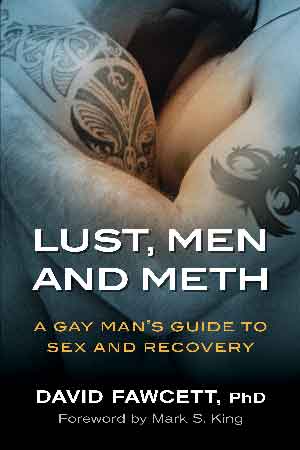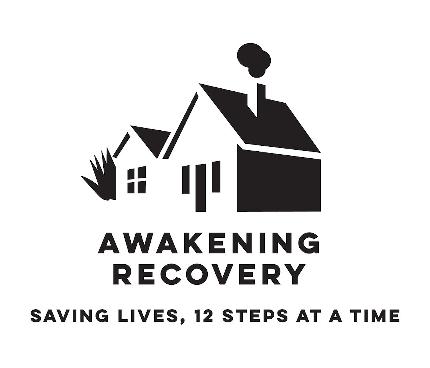
BY DR. DAVID FAWCETT, PhD
PUBLISHER: Healing Path Press
$19.95
210 pages
BY DR. DAVID FAWCETT | In this pair of excerpts from the new book Lust, Men, and Meth: A Gay Man’s Guide to Sex and Recovery, veteran psychotherapist Dr. David Fawcett defines the pitfalls of meth use – and how to overcome them.
In Chapter 8, titled The Recovery Process, Dr. Fawcett explains how meth raises the bar for sexual pleasure to impossible heights. In Chapter 9, titled Healing Old Wounds, the author outlines the steps required to achieve abstinence and attain recovery.
Chapter 8: The Recovery Process | Meth and sex quickly fuse when used in combination, resulting in an inability to experience sexual pleasure once the drug is withdrawn.
The same ability to trigger excessive amounts of dopamine occurs with fantasy. The limbic system cannot differentiate between an actual person who heightens sexual desire and causes a physiological reaction, including a flood of dopamine, and the two-dimensional image on a computer screen or in a sexual fantasy fueled by copious amounts of methamphetamine. The limbic system only knows that it is getting signals that something very desirable is “out there,” and it reacts accordingly by releasing pleasure-inducing dopamine. The limbic system registers such fantasies as real, and with continued use of meth or pornography (or any addictive behavior), such excessive input becomes the minimal level of stimulation required. Amphetamines, and methamphetamine in particular, are equally potent in their ability to induce dopamine release.
Because of the brain’s marvelous ability to adapt, it quickly determines that high levels of stimulation from meth or porn are now “normal,” and these levels become required to trigger the release of dopamine. In real world experience, this means that vanilla sex, human partners (as opposed to pornography), or sex acts without drugs are no longer satisfying because the brain has learned to rely on super-stimulation to function normally. Part of this adaptation is the physical reduction of the number of dopamine receptors on nerve cells known as sensitization. Sensitization also results in the brain needing less and less of the stimulating drug or behavior to result in intense cravings.
The reduction in the number of receptors results in yet another phenomenon of addiction known as tolerance. In drug terms, this means that more of the drug is required to achieve the same effect. Because of the decreased number of dopamine receptors, more stimulation is necessary to result in an “adequate” release of dopamine flowing through these limited receptors.
Another feature of dopamine is its responsiveness to novelty. Because of the brain’s plasticity, it quickly adapts to stimulus. This means that a fantasy that was exciting today won’t suffice tomorrow, or that pornography that was titillating on one day won’t produce the same level of excitement the next. Meth users frequently describe a phenomenon of increasingly dark sexual fantasies and risky behavior. As the brain continually adapts, this escalation is necessary to achieve the same amount of excitement and stimulation. To keep the flow of dopamine, many addicts describe behavior in which they cannot stop cruising online sex sites, or viewing pornography, or leave the bathhouse, because they are constantly seeking more stimulus and something even more exciting.
As this process continues, the brain’s ability to create, combine, and shed neural pathways continues. A common slogan heard in Crystal Meth Anonymous meetings comes straight from neuroscience: “What fires together, wires together.” This process is a key factor in the experience of many meth users who require darker and more extreme sexual acts or fantasies. This accurately describes the process that occurs when neural transmission of dopamine becomes dependent on a meth-induced high (or other drugs as well) combined with sexual thoughts or fantasies. Remember, dopamine is the neurotransmitter that binds behaviors and rewards together. Pavlov’s principle of a dog associating a ringing bell with food (and inducing production of saliva) is totally based on dopamine’s ability to wire all those things together. For the meth user (and the porn addict), being in an addicted state, combined with sexual fantasies and behavior, will fuse these two together. In other words, the brain begins to combine sex and meth in such a way that one becomes dependent on the other. Simply stated, when someone stops using the drug (or porn), sexual desire often disappears right along with it. This loss of sexual desire is a huge concern for recovering meth addicts, and results from the process described above.
Chapter 9: Healing Old Wounds | Unlearning dangerous old behaviors and establishing new ones takes time and considerable effort, but it can be done. Recovery cannot be achieved without the help of others. Meth, like other drugs, is particularly isolating. Of course, this doesn’t mean that meth users don’t have abundant social contacts. Some clients of mine may have had hundreds (or more) sexual liaisons, but remained profoundly lonely and isolated. Recovery requires reconnecting with others in a meaningful way. This can be accomplished by attending self-help groups (such as Narcotics Anonymous, Crystal Meth Anonymous, or Alcoholics Anonymous). Other groups such as SMART Recovery provide an alternative (as well as a complement) to twelve-step groups. A degree of resistance is very normal at first, but I encourage people to force themselves to go and stay in meetings for a period of time. It is important to make a commitment for at least ninety days before declaring that “twelve steps just won’t work for me.”
In addition to support groups, I believe professionally facilitated groups are important as well. Giving up meth requires considerable behavioral changes that involve not only the drug(s) themselves, but reinventing other activities like sex, self-care, and socializing. This process is characterized by addressing lifelong dysfunctional patterns that may include unresolved grief, shame, feeling unworthy, and a host of other issues which, unless corrected, will provide ample material for relapse. Trained facilitators guide this process, resulting in meaningful change of destructive thoughts and feelings as well as the teaching and reinforcement of new skills and behaviors.
Experience shows that all links to these drug-related people, places, and things must be severed. This may mean friends, sex partners, even lovers and husbands. It means giving up the computer (where this is not possible due to occupational necessity, clients have installed censoring software to prevent being drawn into cruise sites or pornography). It may mean changing e-mail and phone number contacts, becoming celibate for a period of time, changing patterns and routines, and sometimes even relocating to a new city where memories and potential cravings are not linked to every corner. It should be cautioned, however, that such a move can easily be driven by a “geographical cure,” in which the recovering person mistakenly employs “magical thinking” and believes that simply relocating to another place will solve all their problems. As many people in recovery are well aware, problems accompany us wherever we go.
Copyright 2015, Dr. David Fawcett. David Fawcett, PhD, is a psychotherapist and writer with a practice in Fort Lauderdale. Florida. His work in gay men’s health, addictions and recovery spans three decades. Fawcett’s writing about substance abuse, mental health and HV appears regularly in TheBody.com and other journals. To order Lust, Men and Meth: A Gay Man’s Guide to Sex and Recovery, visit www.david-fawcett.com.






















